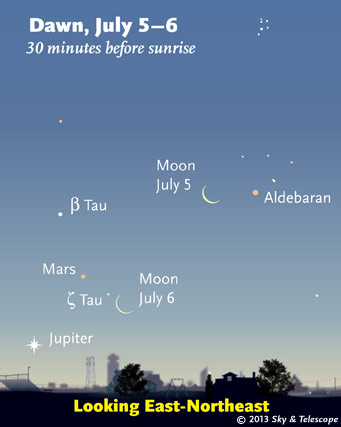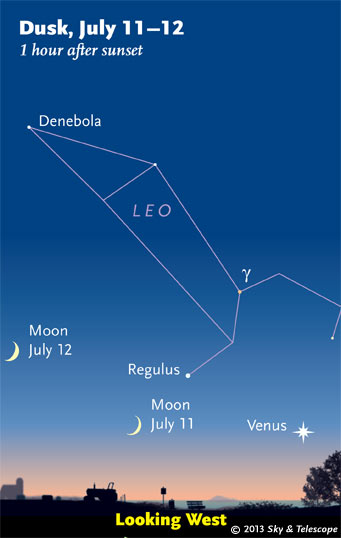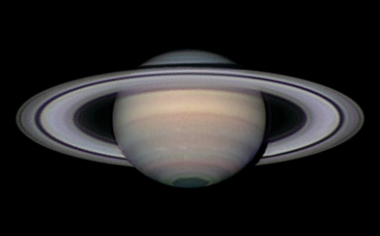Friday, July 5

A very thin waning Moon hangs low in bright dawn on Saturday morning the 6th, amid other low sights. Bring binoculars.
Saturday, July 6
Sunday, July 7
Monday, July 8
Tuesday, July 9
Wednesday, July 10

The Moon comes back to join Venus under looming Leo after sunset. (Moon positions are exact for the middle of North America.)
Thursday, July 11
Friday, July 12
Saturday, July 13
Want to become a better amateur astronomer? Learn your way around the constellations. They're the key to locating everything fainter and deeper to hunt with binoculars or a telescope.
For an easy-to-use constellation guide covering the whole evening sky, use the big monthly map in the center of each issue of Sky & Telescope, the essential guide to astronomy. Or download our free Getting Started in Astronomy booklet (which only has bimonthly maps).

The Pocket Sky Atlas plots 30,796 stars to magnitude 7.6 — which may sound like a lot, but that's less than one star in an entire telescopic field of view, on average. By comparison, Sky Atlas 2000.0 plots 81,312 stars to magnitude 8.5, typically one or two stars per telescopic field. Both atlases include many hundreds of deep-sky targets — galaxies, star clusters, and nebulae — to hunt among the stars.
Sky & Telescope
Once you get a telescope, to put it to good use you'll need a detailed, large-scale sky atlas (set of charts). The standards are the little Pocket Sky Atlas, which shows stars to magnitude 7.6; the larger and deeper Sky Atlas 2000.0 (stars to magnitude 8.5); and the even larger Uranometria 2000.0 (stars to magnitude 9.75). And read how to use sky charts with a telescope.
You'll also want a good deep-sky guidebook, such as Sue French's Deep-Sky Wonders collection (which includes its own charts), Sky Atlas 2000.0 Companion by Strong and Sinnott, the bigger Night Sky Observer's Guide by Kepple and Sanner, or the beloved if dated Burnham's Celestial Handbook.
Can a computerized telescope replace charts? Not for beginners, I don't think, and not on mounts and tripods that are less than top-quality mechanically (able to point with better than 0.2° repeatability). As Terence Dickinson and Alan Dyer say in their invaluable Backyard Astronomer's Guide, "A full appreciation of the universe cannot come without developing the skills to find things in the sky and understanding how the sky works. This knowledge comes only by spending time under the stars with star maps in hand."
This Week's Planet Roundup

Double-shadowed Saturn. Saturn is near eastern quadrature during July and August (90° east of the Sun), so this is when its globe casts the widest shadow onto the rings behind, as seen from Earth's viewpoint. That's the black band on the rings just off the globe at lower right of center (celestial northeast).
Meanwhile, the rings are now casting an almost equally prominent shadow onto the globe. That's the black rim above the rings (south here is up). Both add to Saturn's 3-D appearance in a telescope.
The gray band on the globe just inside the rings is the semitransparent C Ring, the sparse "Crepe Ring," with no shadow currently behind it to confuse its appearance.
Damian Peach shot this extraordinarily fine image through excellent seeing conditions on July 8th.
Mercury is hidden in the glare of the Sun.
Venus (magnitude –3.9) is gradually gaining altitude, shining brightly low in the west-northwest in evening twilight. In a telescope it's still quite small (11 arcseconds) and gibbous (89% sunlit). But for the rest of the year, watch it grow in size and wane in phase until becoming a long, ultra-thin crescent.
Mars and Jupiter are deep in the glow of dawn.
Saturn (magnitude +0.5, at the Virgo-Libra border) glows in the southwest after dusk, with Spica 12° to its lower right. Look about equally far to Saturn's left for fainter Alpha Librae.
Uranus (magnitude 5.8 in Pisces) and Neptune (magnitude 7.9 in Aquarius) are high in the southeast before the beginning of dawn. Finder charts for Uranus and Neptune.
No, we don't call Pluto a planet, but if you've got a large telescope and think you can try for this 14th-magnitude speck in Sagittarius, use the big finder chart in the June Sky & Telescope, page 52. Pluto was at opposition July 2nd.
All descriptions that relate to your horizon — including the words up, down, right, and left — are written for the world's mid-northern latitudes. Descriptions that also depend on longitude (mainly Moon positions) are for North America. Eastern Daylight Time (EDT) equals Universal Time (also known as UT, UTC, or GMT) minus 4 hours.
Like This Week's Sky at a Glance? Watch our SkyWeek TV short, also playing on PBS.
To be sure to get the current Sky at a Glance, bookmark this URL:
http://SkyandTelescope.com/observing/ataglance?1=1
If pictures fail to load, refresh the page. If they still fail to load, change the 1 at the end of the URL to any other character and try again.
 0
0
Comments
You must be logged in to post a comment.